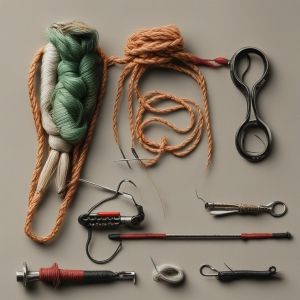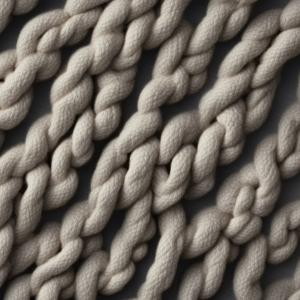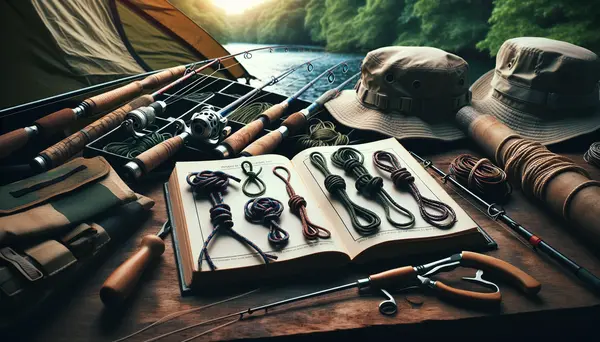Table of Contents:
Fishing knots, the crucial links between the angler and the catch, may often be overlooked in favor of lures and rods. Yet, it is the quality of these knots that can be the deciding factor between a successful fishing outing and a missed opportunity. Learning to tie the right knot is not only essential for your fishing success but also creates a sense of achievement and boosts your confidence. This comprehensive guide will provide the necessary knowledge on fishing knots, focusing on various knot tying techniques and the rationale behind their use.
Introduction to Fishing Knots
Have you ever lost a fish due to a poorly tied fishing knot? If so, you're not alone. One of the most critical skills an angler needs to master is knot-tying. Fishing knots connect your hook, lure, or swivel to your fishing line, ensuring that your setup stays secure even when a big fish bites.
Every angler has their own preferred knots, but there are a few universally recognized, tried-and-true fishing knots that every angler - novice and experienced alike - should know. To guide you through this process, we've put together this complete guide to help you master essential knot-tying techniques. Whether you're a beginner or a seasoned angler, we assure you will benefit from this guide.
We will take you through the step-by-step process on how to tie different knots, when to use them, and why they work. This guide aims to make you an expert in knot tying and increase your chances of a fruitful fishing experience.
Importance of Knot Mastery in Fishing
For many, the importance of knot mastery in fishing might not seem obvious at first. However, the strength and reliability of your knots can make or break your fishing experience. Imagine having fought a big catch for several minutes, only to lose it due to a knot that slips or breaks - a frustrating experience indeed!
Knots are necessary for securely attaching the fishing line to the hook, ensuring that it can withstand the weight and movement of a hooked fish. Therefore, the failure or success of your catch often relies directly on your knot-tying skills. These skills allow you to adapt to different situations, types of line or gear, and species of fish.
Mastering the art of tying fishing knots gives you the adaptive abilities every good angler needs, and significantly increases your chances of a satisfying and rewarding fishing experience. Once you've honed your knot-tying skills, they will become a part of your overall muscle memory, giving you more time and energy to focus on the actual fishing.
Pros and Cons of Mastering Essential Fishing Knots Techniques
| Pros | Cons |
|---|---|
| Increases success rate in catching fish | Requires some time to learn |
| Improves overall fishing experience | Can be tricky to practice in real-life situations |
| Provides a versatile skill set for different fishing conditions | Some knots might be irrelevant for certain types of fishing |
| Enhances safety by ensuring lines are secure | Requires regular practice to maintain proficiency |
Essential Fishing Knots You Need to Learn

As you set out on your fishing journey, there are several important fishing knots that you should acquire proficiency in. These knots will not only ensure a secure and robust connection but also allow for flexibility in different fishing scenarios.
Though there are countless knots used around the world, the following are notable for their strength, reliability, and versatility. Learn these knots well and you will greatly enhance your confidence and effectiveness as an angler.
The Improved Clinch Knot is favorite among many anglers for its simple tying process and its high ratio of line strength retention, making it a go-to choice for tying hooks, swivels, and lures.
The Palomar Knot is renowned for its extraordinary strength. It is a suitable match for braided lines and proves extremely efficient in high load bearing situations.
The Uni Knot, nicknamed the 'universal knot', boasts the desirable trait of adaptability. This versatile knot can be used for attaching the line to the hook, joining two lines, or even for attaching the line to the reel's spool.
Lastly, the Albright Knot serves as the optimal choice for joining two fishing lines of different materials or diameters, providing excellent strength without sacrificing ease of tying.
There's a world of knots out there to explore, but mastering these key knots will give you a firm foundation and ensure you're well-equipped for most fishing situations.
Step-by-step Guide to Tying Fishing Knots
Let's take a closer look at how to tie some of the most popular and efficient fishing knots. These detailed step-by-step instructions will help you master these essential techniques.
The Improved Clinch Knot

This knot is known for its simple and quick tying process. To start, pass the line through the eye of the hook or lure. Wrap the free end around the standing line five times. Then, pass the free end back through the loop nearest to the eye, then back through the big loop you just created. Finally, pull on both the tag end and standing line to snug the knot down onto the eye. Cut off the excess, and you've tied the Improved Clinch Knot.
The Palomar Knot
Begin by doubling your line to make a loop, then push the loop through the hook’s eye. Next, tie a loose overhand knot with the loop. Pass the loop over the end of the hook. Last, pull on both the standing line and tag end to tighten the knot. Make sure the knot is firmly tightened before cutting off the excess.
The Uni Knot

To tie the Uni knot, start by running the line through the hook eye and form a loop by laying the tag end over the standing line. Make at least six turns with the tag end around the standing line and through the loop. Wet the knot and pull both the standing line and the tag end to snug the knot down onto the hook’s eye. Trim the excess line, and the Uni knot is complete.
The Albright Knot
This knot is used to join two lines of different materials or diameters. Make a loop in the heavier line and run about 10 inches of the lighter line through the loop. Wrap the light line back over itself and both strands of the loop. Do this for 10 plus wraps then feed the tag end back through the loop - the same way it came in - and tighten the knot with a steady, even motion. Ensure the coils are in spiraling sequence, and then trim the excess.
Practice makes perfect when tying fishing knots. Take your time mastering these knots, and you’ll improve your angling skills and boost your chances of landing the big one!
Helpful Tips for Perfecting Your Knot Tying Skills
Mastering fishing knots is both an art and a science. Here are a few tips to help you improve your knot tying skills:
Start with the basics: Before trying out complex knots, get a firm grasp of the basic ones. The Improved Clinch, Palomar, Uni, and Albright Knots are excellent starting points.
Practice regularly: Knot tying is a skill that improves with practice. Consider practicing your knots during your downtime so they become second nature when you're out on the water.
Use quality lines: Knot strength relies heavily on the quality of your fishing line. High-quality lines are less likely to break at the knot, ensuring a secure hold.
Test your knots: Don’t wait till you’re out on the water to check the strength of your knots. Test them at home by applying some pressure to make sure they hold.
Moisturize: Lubricating your line before cinching your knot can reduce friction and enable it to hold better. You can simply use spit for this.
Understanding the mechanics behind how and why a knot holds or fails can drastically improve your fishing experiences. Remember, effective knot tying is vital in fishing and equally as important as having superior bait or a top-tier rod. So, don’t skip this crucial step in your angling journey.
Caring for Your Lines and Knots
Proper care for your fishing lines and knots plays a significant role in how productively you fish. No matter how expertly you've tied your knot, if the fishing line itself is in poor condition, it could lead to the undesired 'snap' during the critical moment of landing a catch. It's no secret that fishing lines endure a lot of stress, friction, and exposure to the elements.
Ensuring the longevity of your fishing lines involves routine inspection and handling them with care. Here are a few steps to extend their life. First, avoid direct sunlight. UV rays can weaken the line, reducing its strength over time. Store your gear in a cool, dark place when not in use.
Secondly, be attentive to dirt and grime that can build up on the line. Simple steps such as rinsing your fishing line with fresh water after each use can remove debris. This action helps to prevent the line from becoming brittle or worn due to accumulated salt, sand, and other particles.
Lastly, monitor the line for any signs of wear and tear such as fraying, color fading, or coiling. Don't hesitate to replace your fishing line periodically. Even with the best care, fishing lines are not meant to last forever, and their effectiveness decreases with age and use.
Caring for your knots is equally crucial. Each time you tie a knot, moisten it before pulling it tight. This step reduces friction heat, which can weaken the knot. Practice makes perfect, and the more you tie knots, the better you'll get at them. So take some time to care for your lines and knots, and they'll support you to land the big one on your next trip!
Conclusion: The Path to Becoming a Knot Master
Stepping into the world of fishing knots may initially seem daunting. Yet, with persistence and practice, these knots will become second nature to you, enhancing your overall fishing skills.
Knot mastery is more than just knowing how to secure a hook, it's about understanding why certain knots work better than others in different scenarios. It's about developing adaptability, confidence, and a deep connection to the fishing craft.
Remember, mastering these knots is akin to learning a new language. The more you speak it, the better you get. So, take that fishing line, start practicing and open a world of fishing possibilities. The path to becoming a knot master is in your hands.
We hope that this guide serves as a stepping stone to your knot mastery journey, fostering a more fulfilling and rewarding fishing adventures. Remember, the experience gained from both triumphs and failures will shape your growth. Keep experimenting and learning, and soon, not even the trickiest of knots will be able to elude your skills.
Frequently Asked Questions about Essential Fishing Knots
What are some essential fishing knots I should know?
Some essential fishing knots you should know include the Improved Clinch, Palomar, Uni, Loop, and Bimini Twist knots.
How do I tie a Palomar knot?
A Palomar knot is tied by doubling your line, tying an overhand knot, passing the loop over the hook, and then pulling tight.
When should I use a Bimini Twist knot?
A Bimini Twist knot is great to use when you need a loop at the end of your line. It's commonly used in saltwater fishing for attaching leaders to main lines.
What is an Improved Clinch knot used for?
The Improved Clinch knot is used for securing a fishing line to the fishing lure, snap or swivel. It's strength and reliability makes it popular among freshwater anglers.
How do I perfect the technique of tying fishing knots?
The key to perfecting the technique of tying fishing knots is practice. Start with simple knots and gradually move on to more complex ones as you get comfortable.







